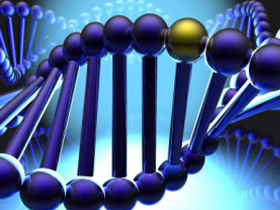 The DNA data bank found in the cell nucleus is made up of nucleic acids expressed in shorthand form by the letters A, T, G and C. The molecules represented by these letters combine together in pairs, with each pair forming a rung in the DNA. Genes emerge through these rungs, one on top of the other. Every gene, part of the DNA molecule, controls a particular characteristic in the human body.
The DNA data bank found in the cell nucleus is made up of nucleic acids expressed in shorthand form by the letters A, T, G and C. The molecules represented by these letters combine together in pairs, with each pair forming a rung in the DNA. Genes emerge through these rungs, one on top of the other. Every gene, part of the DNA molecule, controls a particular characteristic in the human body.
All the physical information regarding a living thing—from height to eye color, from the shape of the nose to blood group—is encoded in its genes. There are some 30,000 genes in the human DNA. Every gene consists of between 1,000 and 186,000 nucleotides, depending on the kind of protein it corresponds to, set out in a specific sequence. These genes contain some 30,000 codes controlling the production of these proteins. The information contained in these 30,000 genes represents just 3% of the total information in the DNA. The remaining 97% is still a mystery.
Genes are found inside chromosomes. The nucleus of every human cell (with the exception of reproductive cells) has 46 chromosomes. If each chromosome were compared to a volume and each gene to a page, there is enough information in one cell—which contains all the features of a human being—to fill a 46-volume encyclopedia. That encyclopedia is equivalent to 920 Encyclopedia Britannica volumes.
The letters in the DNA of every human being are arranged differently. That is why all the billions of people who have ever lived on Earth have been different from one another. The basic structure and functions of organs and limbs are the same in everyone. But everyone is specially created with such finely detailed differences. Even though each human being is the product of a single cell dividing, nobody looks exactly the same as anyone else.
All the organs in your body are constructed within the framework of a blueprint describes by the genes. For example, according to scientists, the skin is controlled by 2,559 genes, the brain by 29,930, the eye by 1,794, the salivary glands by 186, the heart by 6,216, the breast by 4,001, the lung by 11,581, the liver by 2,309, the intestines by 3,838, the skeletal muscle by 1,911 and blood cells by 22,092.
The secret behind your survival as a normal human being lies in the fact that the billions of letters in your cells’ 46-volume encyclopedia are all arranged flawlessly. It is of course impossible for these letters to organize and arrange themselves through their own consciousness and will. The genes we have compared to the pages of an encyclopedia, and their flawless arrangement that rules out the concept of chance, are proof of creation.


